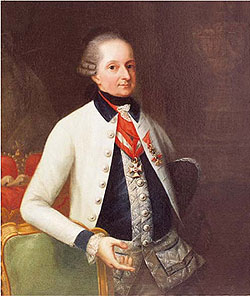Related Research Articles

Franz Joseph Haydn was an Austrian composer of the Classical period. He was instrumental in the development of chamber music such as the string quartet and piano trio. His contributions to musical form have led him to be called "Father of the Symphony" and "Father of the String quartet".

The term string quartet can refer to either a type of musical composition or a group of four people who play them. Many composers from the mid-18th century onwards wrote string quartets. The associated musical ensemble consists of two violinists, a violist, and a cellist.

Carl Philipp Stamitz was a German composer of partial Czech ancestry. He was the most prominent representative of the second generation of the Mannheim School.
The Aeolian Quartet was a highly reputed string quartet based in London, England, with a long international touring history and presence, an important recording and broadcasting profile. It was the successor of the pre-World War II Stratton Quartet. The quartet adopted its new name in 1944 and disbanded in 1981.

Johann Peter Salomon was a German violinist, composer, conductor and musical impresario. Although an accomplished violinist, he is best known for bringing Joseph Haydn to London and for conducting the symphonies that Haydn wrote during his stay in England. He also knew and worked with Wolfgang Amadeus Mozart and Ludwig van Beethoven.

Joseph Martin Kraus, was a German-Swedish composer in the Classical era who was born in Miltenberg am Main, Germany. He moved to Sweden at age 21, and died at the age of 36 in Stockholm. He has been referred to as "the Swedish Mozart", and had a life span very similar to Mozart's.
C major is a major scale based on C, consisting of the pitches C, D, E, F, G, A, and B. C major is one of the most common keys used in music. Its key signature has no flats or sharps. Its relative minor is A minor and its parallel minor is C minor.

A viola concerto is a concerto contrasting a viola with another body of musical instruments such as an orchestra or chamber music ensemble. Throughout music history, especially during the Baroque, Classical, Romantic eras, viola was viewed mostly as an ensemble instrument. Though there were a few notable concertos written for the instrument in this time period, these instances were quite rare and the instrument continued to be ignored. However, during the 20th century, the instrument was revitalized thanks to the work of a number of violists and composers, which led to the commission and composition of many more viola concertos, expanding the repertoire significantly.
B-flat major is a major scale based on B♭, with pitches B♭, C, D, E♭, F, G, and A. Its key signature has two flats. Its relative minor is G minor and its parallel minor is B-flat minor.
G minor is a minor scale based on G, consisting of the pitches G, A, B♭, C, D, E♭, and F. Its key signature has two flats. Its relative major is B-flat major and its parallel major is G major.
D minor is a minor scale based on D, consisting of the pitches D, E, F, G, A, B♭, and C. Its key signature has one flat. Its relative major is F major and its parallel major is D major.

Nikolaus I, Prince Esterházy was a Hungarian prince, a member of the famous Esterházy family. His building of palaces, extravagant clothing, and taste for opera and other grand musical productions led to his being given the title "the Magnificent". He is remembered as the principal employer of the composer Joseph Haydn.
Johan Wikmanson was a Swedish organist and composer.
Gregor Joseph Werner was an Austrian composer of the Baroque period, best known as the predecessor of Joseph Haydn as the Kapellmeister of the Hungarian Esterházy family. Few of Werner's works survive to the present day, and he is mostly remembered for his troubled relationship with Haydn.

Joseph Haydn's Symphony No. 1 in D major, Hoboken I/1, was written in 1759 in Dolní Lukavice, while in the service of Count Morzin. While it is reliably known that No. 1 was written in 1759, H. C. Robbins Landon cannot rule out that No. 2, No. 4, or both could have been composed in 1757 or 1758.
Wolfgang Amadeus Mozart's String Duo No. 1 in G major for violin and viola, K. 423, the first of the two Mozart wrote [see String Duo No. 2 (Mozart)] to complete Michael Haydn's set of six for the Archbishop Colloredo. It was written in the summer of 1783. It is in three movements:
- Allegro, common time
- Adagio, C major, 3/4
- Rondeau: Allegro, cut time
David Wyn Jones FLSW is a British musicologist. He is an expert on music of the Classical period, including that of Haydn and Beethoven.
The String Quartets, Op. 3 are a set of six string quartets published under Joseph Haydn's name by the French music publisher Bailleux in 1777 and subsequently reprinted in 1801 by Maison Pleyel as part of a series of the complete Haydn string quartets.
References
- 1 2 Stevenson, Joseph. "Roman Hoffstetter - Biography". AllMusic. Retrieved 3 October 2011.
- ↑ Alan Tyson and H.C. Robbins Landon, "Who Composed Haydn's Op. 3?" The Musical Times 105 (1964), pp. 506–7.
- ↑ Fruehwald, Scott (1988). Authenticity Problem's in Joseph Haydn's Early Instrumental Works: A Stylistic Investigation. New York: Pendragon Press. pp. 155–163.